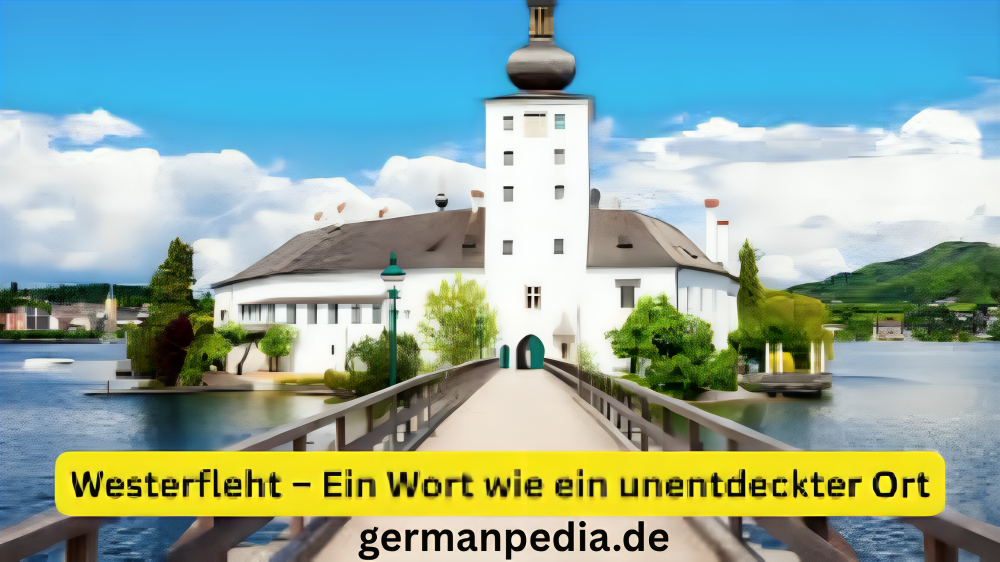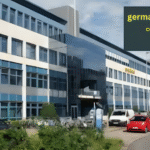Westerfleht, a hidden gem tucked away in the verdant landscapes of Lower Saxony, Germany, invites travelers to step into a world where time seems to pause amidst rolling hills and timeless charm. This quaint village, with its postcard-perfect scenery and warm community spirit, embodies the essence of rural German life at its finest. Whether you’re wandering cobblestone streets lined with half-timbered houses or breathing in the fresh air along a gentle river, Westerfleht promises an uplifting experience that rejuvenates the soul. It’s no wonder that those who visit often leave with a renewed sense of optimism, eager to return to this serene haven.

A picturesque view of Westerfleht, showcasing its half-timbered houses nestled by the river amid rolling hills.
As we delve deeper, you’ll discover why Westerfleht stands out as a beacon of history, nature, and cultural vibrancy. From its ancient roots to modern sustainable practices, this article explores every facet, offering accurate and helpful insights to inspire your next adventure.
The Serene Location of Westerfleht
Nestled in the heart of Lower Saxony, Westerfleht enjoys a prime spot that blends accessibility with seclusion. Perched at around 150 meters above sea level, the village is surrounded by undulating hills, lush meadows, and a silvery brook that meanders through the landscape, eventually joining the larger Aller River. Isn’t it refreshing to imagine a place where the air is crisp, filled with the scent of wildflowers and apple blossoms? This geography not only provides stunning vistas but also supports a mild climate—warm summers perfect for outdoor escapades and gentle winters that blanket the area in a soft, inviting snow.
Getting to Westerfleht is a breeze, especially if you’re flying into Hannover Airport, just about 50 kilometers away. A quick 45-minute drive along scenic rural roads, or a train to nearby Nienburg followed by a short bus ride, brings you right to its doorstep. For the eco-conscious traveler, bikes and e-scooters are readily available at local stations, and the village even has a handy app for rideshares. Once there, you’ll find that Westerfleht’s layout encourages exploration on foot, with paths winding through orchards heavy with fruit and forests teeming with wildlife like deer and birds. This strategic location has historically made it a crossroads for trade, but today, it fosters a peaceful retreat that’s optimistic about preserving its natural beauty for generations to come.
The soil here is loamy and nutrient-rich, ideal for the orchards that dot the hillsides—think apples and plums ripening under the sun. Such features not only enhance the visual appeal but also contribute to a sustainable ecosystem, where rainwater systems and windmills dot the horizon, harnessing clean energy. In essence, Westerfleht’s location isn’t just a backdrop; it’s the heartbeat of a community that thrives in harmony with nature.
Unveiling Westerfleht’s Historical Tapestry
Westerfleht’s history unfolds like a well-preserved scroll, dating back to the 12th century when Saxon settlers first established farmsteads along its fertile floodplains. The name “Westerfleht” itself derives from Old Low German, meaning “western flood plain” or “western field of plenty,” a nod to the occasional floods that enriched the soil for bountiful crops. By the 15th century, it had blossomed into a bustling trade hub, joining the Hanseatic League and exchanging wool, grain, and spices with merchants from afar. Can you picture the excitement of those market days, with stone bridges and guild halls buzzing with activity?
The village weathered storms, quite literally—plagues in the 1620s and the turmoil of the Thirty Years’ War left their marks, but Westerfleht’s resilient spirit shone through. Innovative farming techniques helped it rebound, and by the 19th century, subtle industrial influences arrived without overshadowing its charm. Post-World War II reconstruction emphasized community and green development, turning potential setbacks into opportunities for growth. Today, remnants like the old mill by the stream and the stone church tower stand as testaments to this enduring legacy.
Key historical milestones include:
- The 1247 first documented mention in Saxon records, marking its official parish status.
- Joining the Hanseatic League in the 15th century, which sparked economic prosperity.
- The 1805 integration into the Kingdom of Hanover, igniting a cultural renaissance.
- Post-1990s flood recovery, showcasing modern resilience through community-driven rebuilding.
This rich past isn’t confined to books; it’s alive in the architecture and stories shared by locals, fostering an optimistic view that history informs a brighter future.
Must-Visit Attractions in Westerfleht
When it comes to attractions, Westerfleht packs a punch with sites that blend history, nature, and whimsy. At the heart lies the Old Town Square, a vibrant hub featuring a 300-year-old fountain surrounded by half-timbered houses—perfect for people-watching over a cup of local coffee. Venture uphill to the 14th-century Westerfleht Castle Ruins, where panoramic views stretch across the valleys, offering a sense of awe that’s hard to beat.

The historic Westerfleht Castle Ruins, offering breathtaking panoramic views of the surrounding countryside.
Don’t miss the River Walk Trail, a 5-kilometer path along the brook where you might spot herons or otters. The Gothic Village Church, with its stunning stained-glass windows, provides a peaceful spot for reflection, while the Whispering Well in the woods—an echo chamber for wishes—adds a touch of magic. Other gems include the Sculpture Garden with interactive art and the Village Museum in a 17th-century barn, displaying Saxon folklore and crafts.
For a quick overview, here’s a table of top attractions:
| Attraction | Description | Best Time to Visit | Entry Fee |
|---|---|---|---|
| Old Town Square | Central gathering spot with historic fountain and buildings. | Year-round | Free |
| Westerfleht Castle Ruins | Hilltop ruins with sweeping views; ideal for history enthusiasts. | Spring/Summer | €5 |
| River Walk Trail | Scenic path for wildlife spotting and relaxation. | Dawn or Dusk | Free |
| Village Church | Gothic structure with vibrant stained glass. | Sundays | Donation |
| Whispering Well | Natural echo spot for fun wishes. | Anytime | €1 |
| Sculpture Garden | Outdoor art installations, interactive for all ages. | Summer | Free |
| Village Museum | Exhibits on local folklore and artisan crafts. | Weekends | €3 |
These spots not only highlight Westerfleht’s allure but also encourage visitors to engage deeply, leaving with fond memories and an optimistic outlook.
The Cultural Heartbeat of Westerfleht
Culture in Westerfleht pulses with authenticity, where traditions meet modern flair in a harmonious dance. Artisans keep age-old crafts alive—potters shaping clay from local streams, weavers creating intricate blankets that tell stories of the past. The annual Heritage Festival brings reenactments, folk dances, and storytelling to life, drawing crowds under lantern-lit skies. Midsummer bonfires crackle with songs and laughter, fostering bonds that feel like family.
Music plays a big role too, with Low German folk tunes echoing in the community hall. Elders pass down tales of forest spirits and heroic traders, while younger folks infuse eco-friendly twists into crafts. It’s this blend that makes Westerfleht’s culture so inviting—optimistic about evolving without losing its roots. Visitors often join workshops, trying their hand at basket weaving or wood carving, and leave feeling enriched.
Bullet points on cultural highlights:
- Folk dances and music at festivals, blending tradition with joy.
- Artisan fairs showcasing handmade goods, from pottery to honey.
- Storytelling circles around bonfires, preserving folklore.
- Youth-led initiatives merging old crafts with digital innovation.
In Westerfleht, culture isn’t a relic; it’s a living, breathing force that inspires positivity.
Westerfleht’s Sustainable Economy
Westerfleht’s economy thrives on its agricultural heritage, with fertile lands supporting organic farms, orchards, and beekeeping. From the Hanseatic trade days to today’s farm-to-table ventures, it’s always been about smart, sustainable growth. Young entrepreneurs run microbreweries crafting crisp Pilsners from spring water, while vineyards produce delightful Rieslings.
Tourism bolsters this, with low-impact trails and agritourism on family farms offering immersive experiences. Challenges like rural depopulation are met head-on with remote-work hubs and green energy projects—solar panels on barns and windmills ensure a clean future. The weekly market buzzes with fresh produce, cheeses, and crafts, supporting locals and visitors alike.
Economic pillars include:
- Agriculture: Organic crops, fruits, and dairy.
- Craftsmanship: Weaving, carving, and brewing.
- Tourism: Eco-friendly accommodations and activities.
- Sustainability: Zero-waste initiatives and renewable energy.
This forward-thinking approach paints an optimistic picture for Westerfleht’s prosperity.
Cherished Local Traditions in Westerfleht
Traditions in Westerfleht are the threads that weave the community together. The Harvest Festival, or Erntefest, features oompah bands, dances, and feasts celebrating bountiful yields—it’s a riot of color and cheer. Community tree-planting drives reflect a commitment to the environment, while ethical hunting provides venison for seasonal meals.
Artisan workshops open doors to visitors, teaching skills passed down generations. Folklore nights share tales of mythical beings, keeping the magic alive. Even simple acts, like sharing jokes over fresh Brötchen at the bakery, embody the warm, inclusive spirit.
Notable traditions:
- Bonfire gatherings for storytelling and songs.
- Harvest dances honoring nature’s gifts.
- Craft workshops blending old and new techniques.
- Eco-drives like river clean-ups.
These customs foster optimism, reminding everyone that heritage strengthens the future.
Exciting Notable Events in Westerfleht
Westerfleht’s calendar brims with events that highlight its vibrancy. The annual Craft Fair showcases artisan wares, from willow baskets to carved figurines, drawing artists and buyers. Midsummer Bonfire nights light up the square with music and merriment, while the Heritage Festival reenacts historical trades.
Post-flood rebuilds in the 1990s became symbols of resilience, celebrated yearly. Guided tours, like “Saxon Secrets,” occur weekends, and winter fest markets offer Glühwein and cheer.
Event highlights:
- Heritage Festival: Reenactments and dances.
- Craft Fair: Artisan displays and workshops.
- Bonfire Nights: Songs and stories.
- Weekly Markets: Fresh goods and community fun.
These gatherings infuse Westerfleht with energy and optimism.
Exploring the Natural Wonders of Westerfleht
Nature in Westerfleht is a treasure trove, with rolling hills ideal for biking, meadows blooming with wildflowers, and forests for hiking. The brook teems with trout, perfect for catch-and-release fishing, while orchards invite September harvests.
Biodiversity thrives—deer at dawn, orchids in spring. Mild weather supports year-round activities: kayaking in summer, skiing in winter.
Natural features table:
| Feature | Description | Best Activity |
|---|---|---|
| Rolling Hills | Gentle slopes with panoramic views | Biking/Hiking |
| Apple Orchards | Fruit-laden trees | Picking in Fall |
| Brookside Meadows | Wildflowers and birds | Birdwatching |
| Dense Forests | Marked paths and wildlife | Zip-lining |
This natural bounty encourages an optimistic embrace of outdoor living.
Savoring Culinary Delights in Westerfleht
Food in Westerfleht is hearty and heartfelt, drawing from the land. Start with rye bread slathered in local honey and goat cheese. Kartoffelsuppe, a creamy potato soup, warms the soul, while Rinderbraten—slow-roasted beef with cabbage—satisfies deeply. Don’t forget Apfelstrudel for dessert.
Beverages shine too: Pilsner from the microbrewery or Riesling wines. Seasonal twists include asparagus soup in spring and venison goulash in autumn.
Signature dishes table:
| Dish | Key Ingredients | Season |
|---|---|---|
| Kartoffelsuppe | Potatoes, sausage, herbs | Year-round |
| Rinderbraten | Beef, cabbage, dumplings | Winter |
| Apfelstrudel | Apples, cinnamon, pastry | Fall |
| Venison Goulash | Game meat, paprika, onions | Autumn |
These flavors reflect Westerfleht’s optimistic culinary heritage.
Planning Your Trip to Westerfleht
Ready to visit Westerfleht? Fly into Hannover, then drive or train in. Best times: spring for blooms, autumn for foliage. Stay at cozy B&Bs (€80-150/night) or farm stays for immersion.
A 3-day itinerary:
- Day 1: Explore square, evening bonfire.
- Day 2: Hike ruins, craft workshop.
- Day 3: Market, kayaking.
Pack layers and comfy shoes—optimism awaits!
FAQs
- What is the best time to visit Westerfleht? Spring and autumn offer mild weather and stunning scenery, though it’s charming year-round.
- Is Westerfleht family-friendly? Absolutely, with easy trails, petting zoos, and kid-friendly workshops ensuring fun for all ages.
- How eco-conscious is Westerfleht? Very much so, featuring organic farms, renewable energy, and zero-waste practices.
- What should I eat in Westerfleht? Try the Apfelstrudel for sweetness or Rinderbraten for a hearty meal, paired with local beers.
- Are there guided tours in Westerfleht? Yes, free village walks on Saturdays and themed tours like “Saxon Secrets” provide insightful explorations.
Fazit
In wrapping up, Westerfleht emerges as more than a destination—it’s a testament to resilient beauty and community spirit in Lower Saxony. From its historical depths to natural splendor and cultural vibrancy, every aspect inspires optimism. Whether seeking solace in its meadows or adventure on its trails, Westerfleht leaves an indelible mark, encouraging us to cherish such hidden treasures. Plan your journey today, and let Westerfleht weave its magic into your story.


